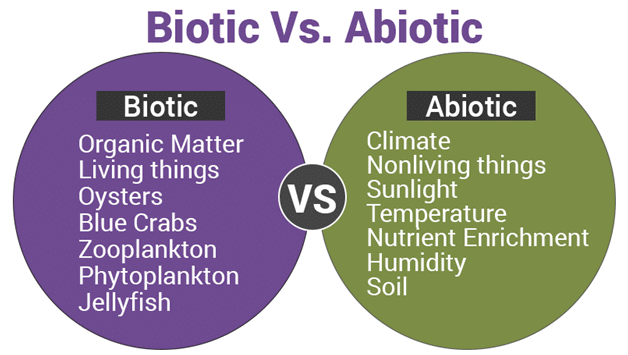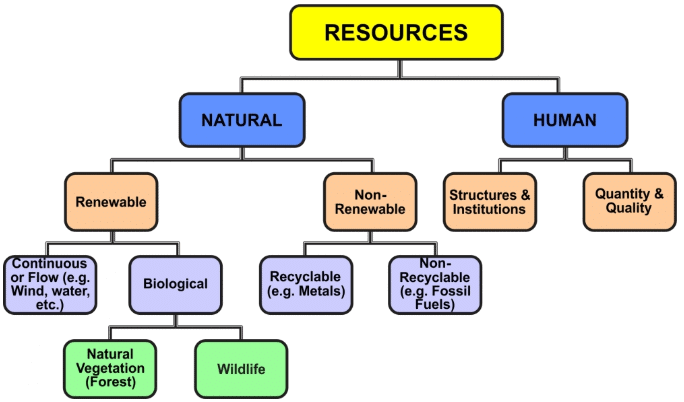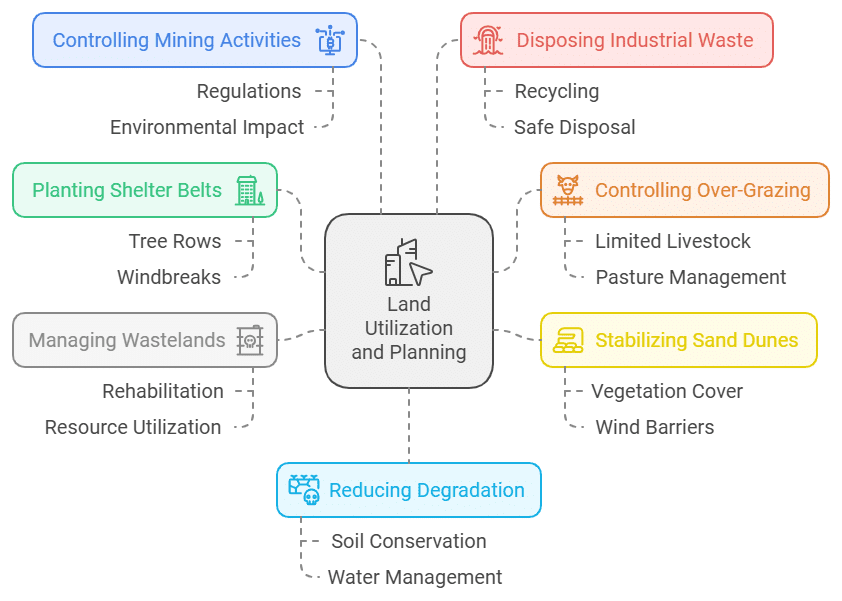Introduction to Resources & Development | Social Studies (SST) Class 10 PDF Download
| Table of contents |

|
| Types of Resources |

|
| Development of Resources |

|
| Resources and Development Planning |

|
| Conservation of Resources |

|
Types of Resources
Resources are everything available in our environment, which satisfy our needs. In fact, human beings themselves are a part of the natural resources. They develop the available natural elements and transform them into ‘resources’ for use.
These are the different types of resources based on various factors:
1. Based on their Origin
- Biotic resources comprise any life form that lives in nature. Like us-human beings, other animals, plants, and all flora and fauna.
- Abiotic resources are available in nature too, but have no life. Like metals, rocks, and stones.

2. Based on their Exhaustibility
- Renewable resources are elements of nature that renew themselves. Solar energy, wind, water, forests etc.
- Non-renewable resources, as the name suggests are limited for use by humans. Like fossil fuels and minerals. Though they would take millions of years to form, eventually, they would get over with continuous use.
3. Based on Ownership
- Individual resources mostly refer to land, property, plantations, farms etc. that people own. The resources that all community members use are Community-owned resources. Like farmlands, properties, pastures, public parks, playgrounds, burial grounds, picnic spots etc.
- National resources are simply everything in nature or man-made that belongs to the country. This includes the territory of oceans and seas. The government of the country has the right to keep, develop or utilize any or all of these resources according to their requirements.
- On the other hand, institutions control and regulate international resources. For using any resource beyond a country’s own, the respective government would need to take permission from these institutions.
4. Based on the Status of Development: Potential, Developed, Stock
- Potential resources are those which are already available in nature. Also, we have already discovered them but are not completely utilized. Solar and wind energy are two of such resources. Despite their current usage, we can explore these resources more.
- Developed resources are quite the opposite. We take years to develop most of the water, fossil fuel, minerals, plants and animals that we use for our need today.
- Stock Resources are ones that have the potential but we do not have the adequate knowledge or technology to develop them. Hydrogen and Oxygen gases can be used as rich sources of energy but we are yet to discover how.
Development of Resources
 Classification of Resources
Classification of Resources
- Nature has blessed us with so many natural resources. And, to add it, humans have learned to develop the gifts of nature and create man-made resources. But none of these come for free. Even though you might think that it occurs in nature, each of these resources will have to be developed, maintained and conserved so our future generations can get benefits from them, like we did.
- Hence resource planning is essential to bring about sustainable existence, which is a part of sustainable development. Sustainable economic development refers to the ‘development of resources without causing any harm to the environment. Also, such development should not compromise with the needs of the future generations.’
Resources and Development Planning
So, how do we plan the resources and development of the same? India is a land of rich natural resources and diversely so. However, while some regions are ahead in their resources and development, other regions lag behind.
Example: States like Rajasthan, Bihar, Jharkhand, and Chhattisgarh, are blessed with minerals and metal ores.
However, they largely lack proper infrastructure and urban resources. In such cases, we need to consider resource planning at the national, state, regional and even local levels. Resource planning involves 3 steps:
- Identifying and documenting the available resources across different regions
- Designing a structured plan supported by innovation and technology
- Matching the resources and development plans with those of the nation
Conservation of Resources
Land Utilization and Planning
Land is the most important natural resource. Over the years, to make optimum utilization of our natural resources, human beings have caused a lot of damages to our land resources. About 95% of our basic needs –food, clothing, shelter come from the land. 
Hence conservation of land resources and development of land is extremely crucial to our future generations can survive.
There are different land planning and conservation measures we can take to protect this natural resource:
- Planting shelter belts for plants
- Controlling over-grazing in open pastures
- Stabilizing sand dunes
- Proper management of wastelands
- Controlling mining activities
- Proper disposal of industrial waste
- Reducing land and water degradation in industrial areas
Soil Conservation
India’s natural landscape and geographical location make it blessed with a different variety of soils in different regions. Moreover, each of these soils yields plants endemic to the region they are found in. However, drastic farming and mass production lead to heavy soil erosion and reduced fertility of the soil.
 Soil conservation methods
Soil conservation methods
There are different methods of controlling soil erosion:
- Contour ploughing to reduce the flow of water during irrigation
- Terrace farming to reduce soil erosion
- Planting shelter belts for plants
|
66 videos|614 docs|79 tests
|
FAQs on Introduction to Resources & Development - Social Studies (SST) Class 10
| 1. What are the different types of resources? |  |
| 2. How are resources developed? |  |
| 3. What is resource development planning? |  |
| 4. Why is conservation of resources important? |  |
| 5. What are some effective methods for resource conservation? |  |





















